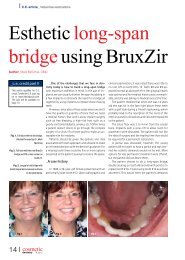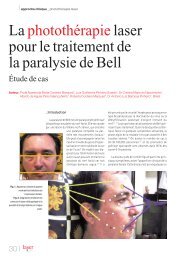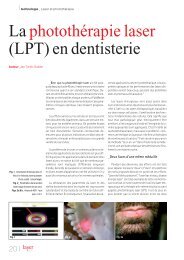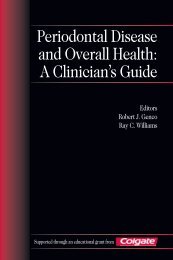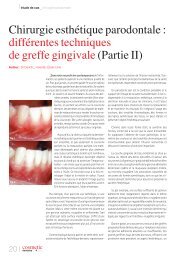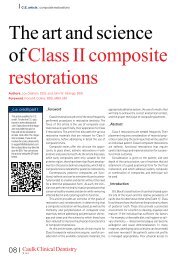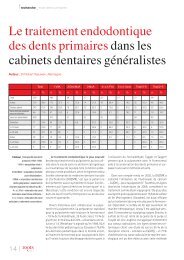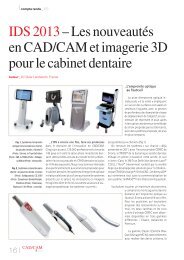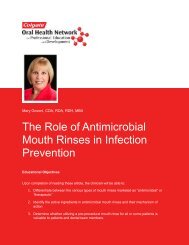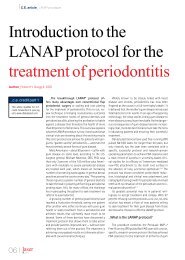Periodontal Disease and Overall Health: A Clinician's Guide
Periodontal Disease and Overall Health: A Clinician's Guide
Periodontal Disease and Overall Health: A Clinician's Guide
Create successful ePaper yourself
Turn your PDF publications into a flip-book with our unique Google optimized e-Paper software.
CHAPTER 4 History of the Oral-Systemic Relationship 45envelopes, use of contaminated telephonereceivers, <strong>and</strong> men with beards.In 1908, Merritt published an article inDental Cosmos with the title “Mouth Infection:the Cause of Systemic <strong>Disease</strong>.” 13 Inthis article he stated that “there is a generaldisposition on the part of the medical <strong>and</strong>dental professions to underestimate therelations which exist between an uncleanmouth <strong>and</strong> many local <strong>and</strong> systemic disordersof grave nature.” He felt that in many casesof malnutrition, the sole cause was a “filthymouth” <strong>and</strong> that “no greater good couldcome to humanity than the full recognition ofthe dangers from this insidious, prolific <strong>and</strong>virulent infection in the human mouth.” Healso stated that “the adoption of proper oralhygiene practices would result in immediate<strong>and</strong> marked improvement to general health<strong>and</strong> notable increase in the average durationof human life.”On October 3, 1910, Hunter was invitedto McGill University in Montreal, Canada, togive the keynote address at the dedication ofthe Strathcona Medical Building. The titleof his address was “The Role of Sepsis <strong>and</strong>Antisepsis in Medicine.” In his address, heblamed “oral sepsis” as the cause of a greatmany diseases, <strong>and</strong> made an attack on conservativedentistry, or as he called it “septicdentistry.” 5 His address was published inThe Lancet, which was the leading Britishmedical journal at the time, as well as in theDental Register. 14,15 Hunter is best rememberedfor the following statement in TheLancet report: “No one has probably hadmore reason than I have had to admire thesheer ingenuity <strong>and</strong> mechanical skill constantlydisplayed by the dental surgeon. Andno one has had more reason to appreciatethe ghastly tragedies of oral sepsis which hismisplaced ingenuity so often carries in itstrain. Gold fillings, crowns <strong>and</strong> bridges,fixed dentures, built on <strong>and</strong> about diseasedtooth roots form a veritable mausoleum ofgold over a mass of sepsis to which there isno parallel in the whole realm of medicine.”He continued with “The worst cases ofanaemia, gastritis, obscure fever, nervousdisturbances of all kinds from mentaldepression to actual lesions of the cord,chronic rheumatic infections, kidney dis -eases, all those which owe their origin to, orare gravely complicated by the oral sepsisproduced by these gold traps of sepsis. Time<strong>and</strong> again I have traced the very first onset ofthe whole trouble to the period within amonth or two of their insertion.” It appearsthat Hunter’s condemnation of conservativedentistry was based primarily on its poorst<strong>and</strong>ard. It was fashionable in London at thetime to mimic complicated Americ<strong>and</strong>entistry. However, in many cases the resultswere often of subst<strong>and</strong>ard quality. Some wellrespecteddentists at the time, such as EdwardCameron Kirk, the editor of Dental Cosmos,recognized the potential systemic effects oforal sepsis, but felt that Hunter’s criticism ofdentistry was unfair as Hunter’s observationswere primarily based on the disastrous effectsof a very low-st<strong>and</strong>ard dentistry. 5In 1911, Billings, the long-servingDean of Medicine at the University ofChicago <strong>and</strong> head of the focal infection researchteam at Rush Medical College <strong>and</strong>Presbyterian Hospital, replaced the term“oral sepsis” with “focal infection.” Soonafter that, he was honored with being askedto give the annual Lane Memorial Lectureat Stanford University in 1915. There, hedefined a focus of infection as a “circumscribedarea of tissue infected with pathogenicorganisms” <strong>and</strong> said that the term focalinfection implied that: (1) such a focus orlesion of infection existed, (2) the infectionwas bacterial in nature, <strong>and</strong> (3) it was ca pableof dissemination, resulting in systemicinfection of other contiguous or noncontiguousparts. The teeth, tonsils, adenoids,<strong>and</strong> mastoids were thought to be the usualsources of bacteremia, <strong>and</strong> certain bacteria,such as streptococcus <strong>and</strong> pneumococcus,



